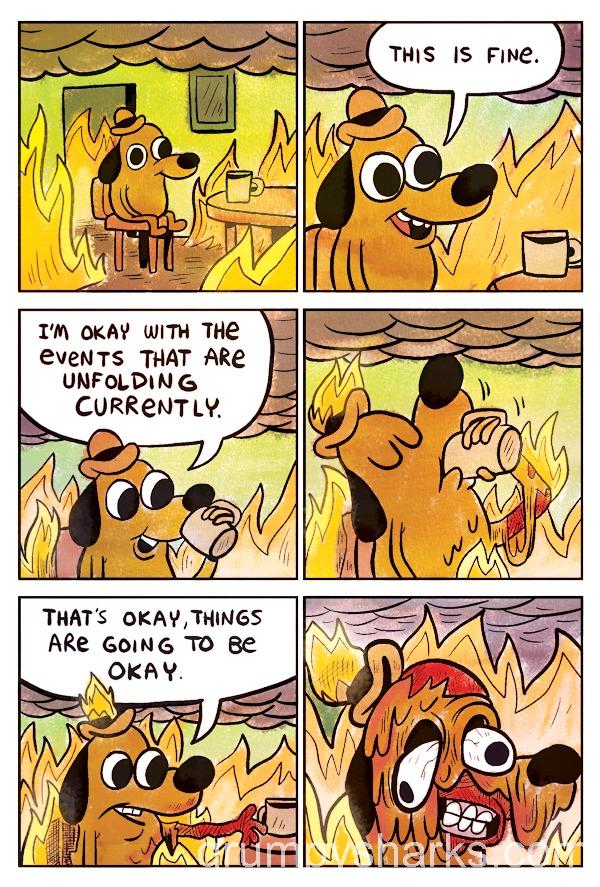What Is the ‘This Is Fine’ Meme? Origin, Meaning & Why It Still Resonates
The “This Is Fine” meme, depicting an anthropomorphic dog sitting calmly amid a blazing room, has become a cultural touchstone for expressing ironic acceptance in chaotic times. Originating from a 2013 webcomic, its simple yet profound imagery captures the absurdity of staying composed during crises, resonating across social media and beyond. This article explores its origins, meaning, viral spread, and enduring relevance, supported by key examples and insights.
Origins of the “This Is Fine” Meme
The Comic Strip by KC Green
The “This Is Fine” meme stems from a six-panel comic titled On Fire, created by artist K.C. Green for his webcomic series Gunshow. Published on January 9, 2013, the comic introduced a character named Question Hound, a dog grappling with existential dread. Green, known for his quirky and introspective comics, crafted the strip to reflect personal moments of denial in overwhelming situations. The comic’s raw emotional honesty laid the foundation for its viral potential.
The Scene: A Dog in Flames
The iconic two-panel image shows Question Hound sitting at a table, flames engulfing the room, with the caption “This is fine.” In the full strip, the dog’s calm facade crumbles as it acknowledges the chaos, sweating and panicking. The stripped-down meme version, focusing on the first two panels, amplifies the irony of denial, making it instantly relatable. Its stark visual—bright flames against the dog’s serene expression—became a perfect reaction image.
Early Online Appearances and Meme Adoption
The comic gained traction after appearing on platforms like Reddit and Tumblr in mid-2013. A Reddit post on r/funny in June 2013 titled “This is fine” garnered thousands of upvotes, signaling its meme potential. By 2014, Twitter users began sharing the two-panel image as a reaction to personal and societal frustrations, from workplace stress to political scandals. Its early spread on these platforms cemented its place in internet culture.
What Does “This Is Fine” Mean?
Literal vs. Ironic Interpretation
At face value, the meme depicts a dog ignoring a fire, symbolizing denial in a crisis. Its ironic power lies in highlighting self-delusion—pretending all is well despite obvious disaster. For example, users might post it to mock someone ignoring a failing project or societal collapse. The contrast between calm and chaos makes it a versatile commentary on human behavior.
Internet Culture and Coping Mechanisms
The meme thrives in internet culture as a humorous way to cope with stress. During overwhelming events—like the 2016 U.S. election or global crises—users shared it to express collective exhaustion. Memes, as scholar Ryan Milner notes, serve as “digital shorthand” for complex emotions, allowing people to laugh at dysfunction rather than despair. “This Is Fine” became a go-to for processing modern anxieties.
Psychological and Cultural Resonance
The meme taps into universal feelings of helplessness, amplified by real-world events like climate change or economic instability. In 2020, it surged during the COVID-19 pandemic, with users pairing it with headlines about rising cases or policy failures. Psychologically, it reflects “doomism,” where people accept grim realities with grim humor, resonating with a generation facing constant uncertainty.
Why the “This Is Fine” Meme Went Viral
Visual Simplicity and Emotional Clarity
The meme’s minimalist design—two panels, a dog, and flames—delivers instant emotional impact. Its clear message requires no explanation, making it universally accessible. As digital culture expert An Xiao Mina notes, simple visuals transcend language barriers, amplifying shareability. The dog’s deadpan expression mirrors feelings of resignation, connecting with millions globally.
Shareability in the Age of Doomscrolling
In the era of doomscrolling, where users consume endless bad news online, “This Is Fine” offers a quick, cathartic release. Its brevity suits platforms like Twitter, where it became a staple for reacting to breaking news, from Brexit to natural disasters. A 2018 tweet pairing the meme with a wildfire headline gained over 10,000 retweets, showing its fit for rapid, emotional sharing.
Institutional & Corporate Use
Brands and institutions adopted the meme, often clumsily. In 2018, a news outlet used it to caption a story about political gridlock, drawing criticism for trivializing serious issues. Politicians, like North Carolina Senator Richard Burr referencing the “This Is Fine” meme while discussing Russian interference in United States politics, also leaned on its irony. While some uses felt tone-deaf, they underscored the meme’s cultural penetration.
Referencing internet meme, Sen. Richard Burr says of Russian interference efforts: “Some feel that we as a society are sitting in a burning room, calmly drinking a cup of coffee, telling ourselves ‘this is fine.’ That’s not fine.” https://t.co/Yr9SwxBwyk pic.twitter.com/w4VUPRMWWi
— ABC News (@ABC) August 1, 2018
The Meme’s Evolution and Enduring Popularity
Variants and Spin-Offs
Fans remixed “This Is Fine” into GIFs, videos, and parodies. A popular 2016 GIF added animation to the flames, enhancing its dramatic effect. Others replaced the dog with characters like SpongeBob or politicians, tailoring it to specific contexts. These variants, shared across TikTok and Instagram, kept the meme fresh and adaptable.
The Meme as Social Commentary
The meme has been a lens for crises, from the 2016 election to 2021’s Capitol riot. During the 2020 wildfires, Greenpeace tweeted it alongside climate change warnings, amplifying its environmental commentary. Its ability to encapsulate collective dread ensures its relevance across contexts, from personal struggles to global issues.
KC Green’s Response and Reinterpretation
K.C. Green has embraced the meme’s success, though he’s noted its bittersweet impact. In a 2016 interview, he expressed surprise at its global reach but discomfort with corporate co-opting. He later created a follow-up comic in 2020, This Is Not Fine, showing the dog fighting back, reflecting hope amid chaos. Green’s engagement keeps the meme grounded in its original intent.
“This Is Fine” in Today’s World
A Symbol of Collective Resilience or Resignation?
The meme walks a fine line between satire and fatalism. For some, it’s resilient humor—laughing to cope with hardship. For others, it normalizes inaction, as seen in critiques during climate protests, where activists argued it downplays urgency. Its dual nature reflects society’s struggle to balance awareness with action.
Psychological Relevance in Modern Life
In 2025, the meme remains relevant amid ongoing global challenges, from economic uncertainty to political polarization. Psychologists note humor helps process trauma, but over-reliance on memes like “This Is Fine” can signal avoidance. Its continued use on X reflects its fit for expressing modern disillusionment.
When Humor Fails: Critiques of Meme Fatigue
Critics argue the meme risks normalizing dysfunction. A 2021 study on meme culture suggested overusing ironic humor can desensitize users to real issues, like policy failures or environmental crises. Some X users have called it “overdone,” urging new ways to express dissent. Yet, its persistence shows its unmatched ability to capture the zeitgeist.
Conclusion
The “This Is Fine” meme, born from K.C. Green’s 2013 Gunshow comic, captures the irony of denial through a dog calmly facing a fiery crisis, resonating as a symbol of modern existential humor. Its viral spread, fueled by visual simplicity and emotional clarity, reflects internet culture’s knack for processing collective anxiety, from political turmoil to climate crises.
Evolving through fan remixes and institutional use, it remains a potent social commentary, balancing satire with critiques of fatalism. As it endures in 2025, “This Is Fine” mirrors society’s struggle with resilience and resignation, cementing its place in digital discourse.









